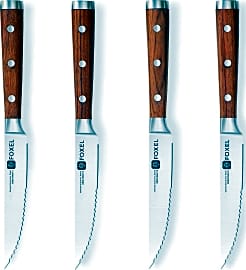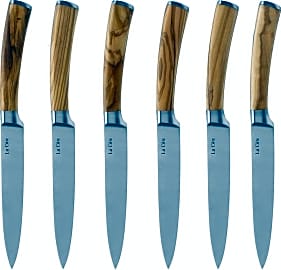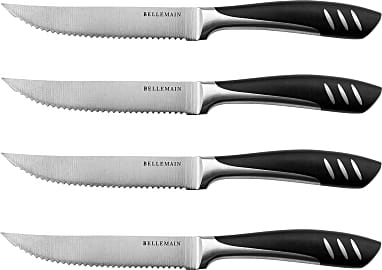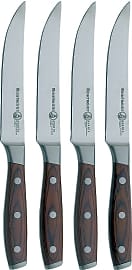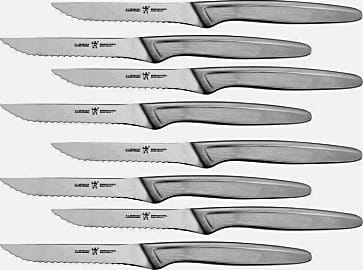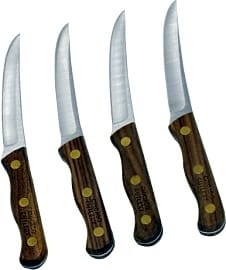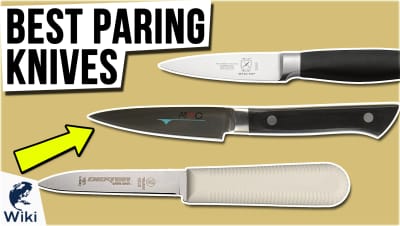The 9 Best Steak Knives

This wiki has been updated 41 times since it was first published in March of 2015. Nothing ruins the experience of enjoying a well-cooked cut of meat faster than having to saw away at it with a dull, ineffectual blade. Whether you are looking to enhance your cutlery collection at home or you run a restaurant and need to add to your supply, our selection of steak knives includes something that will suit every use and decor, and they come in at price points to meet any budget. When users buy our independently chosen editorial choices, we may earn commissions to help fund the Wiki.
Editor's Notes
August 10, 2020:
When updating this list we wanted to strike a balance between serrated and straight-edge varieties, although we slightly favored straight-edged blades as they're generally better at slicing through meat without tearing it. The benefit of serrated selections is that they need to be sharpened sparingly, which is more convenient if you're not eating meat so often that you'll dull them anytime soon.
We said goodbye to the Victorinox brand due to overwhelming complaints of a chemical smell emitting from the handles. Despite the solid quality, having an unwelcome fragrance overwhelm the aroma of your meal is a dealbreaker. We decided to bring on the Chicago Cutlery Tradition in their wake. These chunky, steakhouse-style knives are an ideal starter set for someone who wants something solid and reliable at an affordable price. They also complement farmhouse decor rather nicely.
We removed the Dalstrong Gladiator Series due to edge-retention issues and supplanted them with the sleek Dalstrong Shadow Black Series. The company goes above and beyond to ensure this set will slice through meat effortlessly and last a long time with vigorous use. Among the extensive list of features, these knives have angular, military-grade handles that can withstand plenty of abuse, heat-treated and ice-tempered blades, added chromium for stain resistance, and a hand-polished satin finish.
April 29, 2019:
Finding the best set of steak knives for you comes down to a few personal preferences: the color and material of the handles, whether you like smooth or serrated blades, and how much money you want to spend. The Cangshan S1 Series are both attractive and practical, made from durable materials with German steel blades and elegant white handles that will match any kitchen decor. The J.A. Henckels International have a sleek all-steel construction with slim, almost dainty handles, but they are rather short and may be uncomfortable for users with large hands. The La Cote Straight make great conversation-starters, with handmade olive wood handles that expose their full tang construction, and the wood is harvested sustainably and resistant to bacteria and odors. If you prefer a more traditional look, the Dalstrong Gladiator Series and Wüsthof Classic have triple-riveted black handles that will never go out of style, but the latter are a bit on the pricey side for four knives. If you're shopping on a budget, it's hard to do better than the Bellemain Premium, which don't skimp on quality with their full-tang surgical steel blades and ergonomic handles.
Special Honors
Laguiole en Aubrac Mixed Burls Hailing from France's historic Laguiole region, an area noted for its expertly crafted knives, each utensil in this Mixed Burls set from Laguiole en Aubrac is handmade by a single master cutler. It contains six heirloom-quality steak knives with blades made using Sandvik high-performance steel, which is known for being razor-sharp, extremely hard, tough, and resistant to corrosion. This collection is presented in an elegant wooden box and should last for generations. laguioleenaubracshop.com
FN Sharp For those looking for something durable and high-end, there's this premium set from FN Sharp. It includes four implements made with 67-layer Japanese Damascus VG-10 steel that has a lovely feathered pattern and excellent edge retention and rust and chip-resistance. The handles are crafted from glass-based epoxy resin laminate that feels good in the hand and is extremely strong. They come with three complimentary cycles of sharpening, providing you a fresh set of knives while the originals are sent to restore their edge. fnsharp.com
Cuts Like A Knife
I know when I was a kid, I had to wait until I got a little older to completely participate in kitchen activities like chopping, mincing, dicing, or even cutting my own meat.
Depending on how you were brought up, a good knife might seem like a right of passage. I know when I was a kid, I had to wait until I got a little older to completely participate in kitchen activities like chopping, mincing, dicing, or even cutting my own meat.
That can be devastating to a five-year-old with a keen interest in the culinary arts, and when I finally did get my hands on the knife and the cutting board I was hooked.
As adults, we sometimes take our cutting permissions for granted, content to push any old piece of metal through our food.
It often takes a rare experience with a stellar knife to open our eyes to what's truly possible at the dinner table, and all of these knife sets offer you such an experience.
They do so by providing you with incredibly sharp edges that can slice through even the toughest meats. In the options we have listed, those edges are either serrated or flat, and the difference between the two is significant.
Serrated edges have those visible teeth to them, making the knives look like little saws, and those teeth bite into whatever you're cutting to tear it as you slide the blade through the meat.
The advantage of a serrated set is that it requires less maintenance and sharpening. The disadvantage is that your cuts of meat might not be as smooth on the palate.
Also, when it does come time to sharpen a serrated edge, you can't use a simple tool, as you can with flat edged blades.
Flat edges are much easier to sharpen, as they work more like razor blades, employing an edge so thin that it attains a kind of microscopic serration to it. Your cuts of meat are much smoother, and maintenance, though required more often, is easier.
A Knife For Every Knight
King Arthur had a big, round table for himself and his twelve fellow knights. That's thirteen place settings for dinner.
Fortunately, the Knights of the Round Table all had their own very large, very sharp steak knives: their great swords.
It seems like a minor consideration, but it might just guide your hand that much closer toward or away from that set that caught your eye in the first place.
Chances are your guests won't be arriving with that kind of hardware in tow, so it behooves you to have some great steel waiting for them to wield.
If you have thirteen knights descending on your home, you're going to need more than one of the knife sets we're looking at, the largest of which comes with eight knives.
So, in addition to asking yourself whether you want flat or serrated edges on your steak knives (see the comparison above), and in addition to asking yourself whether you care that the knives look as good as they cut, there's one more simple question to answer.
How many knives do you need? Are you a family of six? A four piece set won't cover you. It seems like a minor consideration, but it might just guide your hand that much closer toward or away from that set that caught your eye in the first place.
From Flint To Steel
Ancient knives made from carved flint have been found around the world dating back over a million years.
Now, that wasn't technically a steak knife, since pretty much every cutting knife had a sharp edge to it in the West, until after the Second World War.
For millennia in the Western world, the only things people ate with were knives and their hands. Elsewhere, in the eastern Asian countries specifically, knives were only used in the kitchen, and were forbidden at the table.
Developments in steel forging after WWII made commercially viable the easily sharpened, stainless steak knives we all use today.
Will steak knives disappear if the country eventually goes vegetarian? Probably not.




